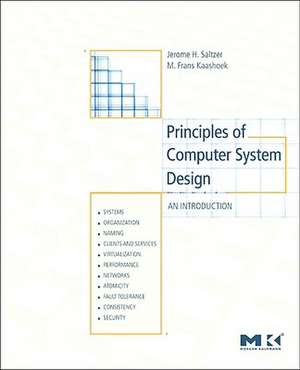Principles of Computer System Design: An Introduction
Autor Jerome H. Saltzer, M. Frans Kaashoeken Limba Engleză Paperback – 21 iul 2009
Through carefully analyzed case studies from each of these disciplines, it demonstrates how to apply these concepts to tackle practical system design problems. To support the focus on design, the text identifies and explains abstractions that have proven successful in practice such as remote procedure call, client/service organization, file systems, data integrity, consistency, and authenticated messages. Most computer systems are built using a handful of such abstractions. The text describes how these abstractions are implemented, demonstrates how they are used in different systems, and prepares the reader to apply them in future designs.
The book is recommended for junior and senior undergraduate students in Operating Systems, Distributed Systems, Distributed Operating Systems and/or Computer Systems Design courses; and professional computer systems designers.
- Concepts of computer system design guided by fundamental principles
- Cross-cutting approach that identifies abstractions common to networking, operating systems, transaction systems, distributed systems, architecture, and software engineering
- Case studies that make the abstractions real: naming (DNS and the URL); file systems (the UNIX file system); clients and services (NFS); virtualization (virtual machines); scheduling (disk arms); security (TLS)
- Numerous pseudocode fragments that provide concrete examples of abstract concepts
- Extensive support. The authors and MIT OpenCourseWare provide on-line, free of charge, open educational resources, including additional chapters, course syllabi, board layouts and slides, lecture videos, and an archive of lecture schedules, class assignments, and design projects
Preț: 346.40 lei
Preț vechi: 505.83 lei
-32% Nou
Puncte Express: 520
Preț estimativ în valută:
66.28€ • 69.39$ • 54.85£
66.28€ • 69.39$ • 54.85£
Carte tipărită la comandă
Livrare economică 31 martie-14 aprilie
Preluare comenzi: 021 569.72.76
Specificații
ISBN-13: 9780123749574
ISBN-10: 0123749573
Pagini: 560
Ilustrații: 121 illustrations
Dimensiuni: 191 x 235 x 30 mm
Greutate: 0.95 kg
Editura: ELSEVIER SCIENCE
ISBN-10: 0123749573
Pagini: 560
Ilustrații: 121 illustrations
Dimensiuni: 191 x 235 x 30 mm
Greutate: 0.95 kg
Editura: ELSEVIER SCIENCE
Public țintă
Junior and Senior undergraduate students in Operating Systems, Distributed Systems, Distributed Operating Systems and/or Computer Systems Design courses.Professional computer systems designers.
Cuprins
1. Systems2. Elements of Computer System Organization3. The Design of Naming Schemes4. Enforcing Modularity with Clients and Services5. Enforcing Modularity with Virtualization6. Performance7. The Network as a System and as a System Component8. Fault Tolerance: Reliable Systems from Unreliable Components9. Atomicity: All-or-Nothing and Before-or-After10. Information Security11. Suggestions for Further ReadingGlossaryProblem SetsIndex of Concepts
Recenzii
"This is a unique, ambitious, and important book. It is about computer system design principles, and not the usual mechanics of how things work. These principles are typically embedded in research papers (for those of which are to be found at all), and no book I know of makes so many of them explicit and its focal point." --Joe Pasquale, UC San Diego"The book is a great introduction to system design issues that are only taught at few courses in few universities, even-though they show up in computer systems everywhere. This is a very good and easy read for any one in computer industry. It describes all parts of computer systems and how they interact very well. The extension of the book is online and many chapters are available for free to download. The chapter on Naming is worth the money of the book. I have not seen the discussion of naming in such detail and simple terms anywhere. The authors are very well respected professors at MIT and have experience in operating systems and computer system since its early days. I highly recommend this book to any hardware or software student or professional engineer." --Amazon.com 5 star review THE missing link, January 16, 2010 By clivebaker "clivebaker""[A] unique of several design patterns that are used as building blocks in computer systems. The primary novelty in Saltzer and Kaashoek’s book is the fresh and original presentation of several related topics. The book is logically divided into two parts: Part 1 is included in the hard-copy book; Part 2 is only available online…. I highly recommend this well-written and well-structured book to several groups of readers: undergraduate students can use it as a gentle introduction to computer architecture and OSs, and graduate students and more advanced readers will enjoy its philosophical and design-oriented aspects. In fact, the book may eventually become a classic and a must-read for any computer scientist." --Computing Reviews










